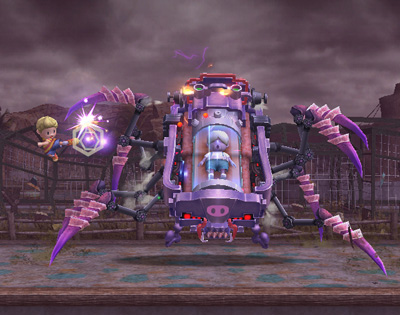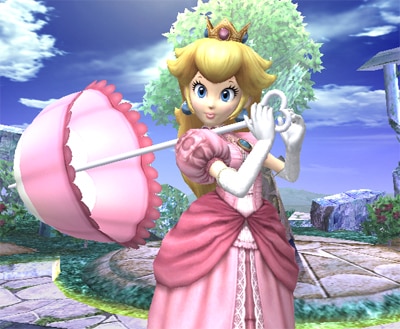 |
| Boss battles are kind of fun though! |
...but I lost all the hidden characters on my Wii when I migrated save data to the Wii U, and you can't use GameCube controllers with a Wii U, so you can see I was in quite a bind.
 |
| Pictured: The Old Way |
The game itself is basically a series of platforming levels and fights with smaller enemies, big bosses, and the game's characters, and you slowly add characters to a number of separate parties that occasionally come together or separate. Since I was playing through it a second time, I thought I'd talk a little bit about some of the design decisions that had to be made in order to create a gameplay mode like this. Things like...
What characters go where
For any given level you'll have a choice between a number of different characters, switching between them when you lose a life. What this means is that the characters you're using have to be appropriately matched to the level. Given how broadly the characters differ, this is a bit tricky, and there's definitely a lot of variation in the levels. For example, one level with Mario and Pit - two characters with high jumps - is relatively vertical and includes a number of complicated platforming pieces. In a level with Donkey Kong and Diddy Kong - one character with very little vertical jumping ability, and another with a complicated and difficult third jump - there are few jumping pieces, with barrels that can launch your characters used to vary the movement through the level. So when designing a level, deciding what characters can be used affects what the structure of the level might be, and vice versa. It also brings up our next question:
What characters go with each other
Sometimes the lowest common denominator sets the level up, and a character without much jumping ability (Marth) is found on a flat level with a character with a lot of jumping ability (Meta Knight). Once Meta Knight is included on a level with characters who can jump (Ice Climbers), the design changes dramatically, forcing the player to continue jumping upward. The designers have balanced stages relatively well for jump height, but less well for movement speed; fast and slow characters do occasionally appear in the same level. This isn't usually an issue for a single player, but with two, one may often leave the other behind, which can be frustrating since the action centers on the first player. Moreover, because the story focuses on a number of different groups of characters in several different places, characters tend to stay united once they've met up in the story - meaning that subsequent levels have to be accounting for any of four, five, or more characters. Later levels reflect this, tending to be more about combat than platforming, but this feature results in more complexity:
What characters go with the story
The Subspace Emissary is not strictly on the same playing field as the Odyssey, or even Ocarina of Time. It clocks in maybe around Donkey Kong Country in terms of narrative sophistication - though it does make the wise choice of omitting any dialogue whatsoever, which by itself would have made Metroid: Other M about 300% better. Still, it has a story of sorts, one that involves characters fighting each other, rescuing one another, travelling across weird, disappointingly generic landscapes, and teaming up to defeat a big scary final boss. This doesn't complicate the gameplay, but it must be managed - if four characters will be in this level you need an explanation for why, and if one leaves but two more arrive for the next level, you again need an explanation. Sometimes the story and gameplay tether nicely - for example Bowser and Ganondorf, two of the main antagonists, are also very heavy characters who can't jump very high. Setting them up as villains means they aren't playable until the end of the game, and obviates designing levels that accommodate their lousy jumping. Other times, things are a little weirder - characters like Olimar are shoehorned into the plot without much accommodation, and in general (as you might expect with such a huge cast) a lot of them end up being vestigial in the story. Which is basically fine until you take a step back and consider...
What The Subspace Emissary has to do with the rest of the game
This, to me, is the mode's biggest failing. My favorite criticism of Starcraft 2's plot goes something like this: The purpose of the single-player game is to creat a context for the multiplayer game. In the original Starcraft, the single-player has all three races - Protoss, Terran, Zerg - fighting one another, and themselves, over everything, and it's all we needed for that multiplayer to work. It's like chess: the pieces represent a royal court, and the game is two kingdoms going to war with each other. Actual war provides the context for chess - it helps us make the stakes clear in our minds - and the single-player mode of Starcraft sets the stakes for the multiplayer one. This is (one reason of several) why the plot of SC2 disappointed; it didn't set up enough of these conflicts clearly enough, and happened in a section vacuum-sealed from the multiplayer elements.
Similarly, The Subspace Emissary doesn't really give us a reason for why the characters are fighting one another. Why anyone's fighting Bowser? Sure; he's a bad guy. Why Peach is fighting Pikachu? Um...
 |
| There is hate in those eyes. |
All this said, I've been having an enormous amount of fun playing with my housemate. Smash Bros. is hard to take too seriously because it's always just been about fun, sometimes nonsensical. There's an element of humor, of randomness, of "that just happened for no real reason, go for it", and on the balance it works.
Also, we've now unlocked just about every character, so we can go back to everybody just playing as Snake, all the time.
 |
| It is how the game is meant to be played. |
No comments:
Post a Comment